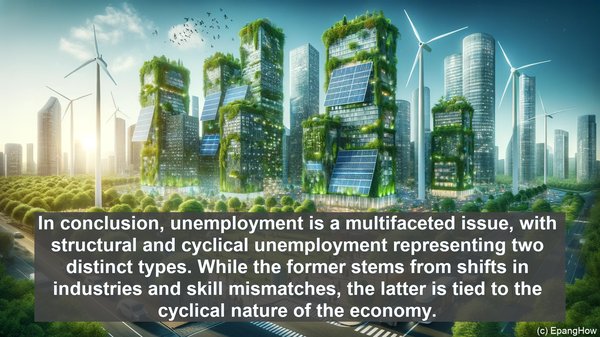Introduction: Unemployment as a Multi-faceted Phenomenon
Hello everyone, and welcome to today’s discussion on unemployment. While it’s often portrayed as a singular concept, unemployment actually encompasses various forms, each with its own causes and implications. Today, we’ll be focusing on two prominent types: structural unemployment and cyclical unemployment.
Structural Unemployment: A Result of Changing Industries and Skill Mismatches
Structural unemployment arises when there’s a fundamental shift in the economy, leading to a mismatch between the skills workers possess and those in demand. One common cause is technological advancements. As industries evolve and become more automated, certain jobs may become obsolete, rendering workers in those fields unemployed. Additionally, globalization plays a role. With the interconnectedness of markets, companies may choose to relocate operations to regions with lower costs, leaving workers in their original location without employment opportunities. In both cases, the issue lies in the disparity between the skills workers have and the skills needed in the evolving job market.

Cyclical Unemployment: The Ebb and Flow of Economic Cycles
Unlike structural unemployment, which is tied to long-term changes, cyclical unemployment is more closely linked to the overall state of the economy. It occurs during periods of economic downturn, such as recessions. When businesses face a decline in demand for their products or services, they often resort to layoffs, resulting in a rise in unemployment. The key characteristic of cyclical unemployment is its temporary nature. As the economy recovers and growth resumes, many of those who were previously unemployed find new job opportunities.

Impacts and Challenges: The Consequences of Unemployment
Regardless of the type, unemployment has far-reaching effects. On an individual level, it can lead to financial strain, reduced well-being, and a loss of skills. From a societal perspective, high levels of unemployment can result in decreased consumer spending, slower economic growth, and even social unrest. Addressing unemployment, therefore, is crucial for both the individuals affected and the overall health of the economy.
Policy Considerations: Tackling the Unemployment Challenge
Given the distinct causes of structural and cyclical unemployment, the approaches to addressing them also differ. For structural unemployment, retraining and upskilling programs can be effective. By equipping workers with the skills in demand, they become more employable in the evolving job market. Cyclical unemployment, on the other hand, often necessitates broader economic measures. Government interventions, such as fiscal stimulus or monetary policies, can help stimulate demand and create job opportunities during downturns.
